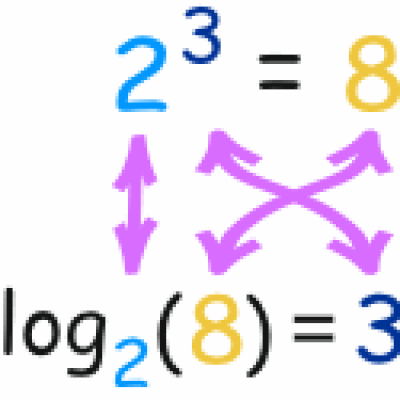If 5^2 = 25
Then square root of 25 =5
If 3^5 = 243
(?)243 = 5
Inverse function of square is square root. 3 to the power 5 is 243. What is its inverse function? Here logarithm appears.
Log 3 (243) =5
3---base
5---power
Meaning : Logarithm of 243 to the base 3 is 5. Hence, "logarithm of x is the power of a number (base) which yield x.
Usually, logarithm of base 10 is used. Because it is easy to find the decimal places.
Example 10^3 = 1000
Log10 (1000) = 3.000
Logarithm of base 2 is used to find, how many times a 'thing' has doubled
Suppose, we play a game in which money is doubled for every win. Say, total money earned is 4096 dollars. How many times the game was won? Or how many times the money has doubled? We can just use log.
Log 2 4096 = 12 times.
Base 2 logs are used in radioactivity and musical theory.
We know e = 2.71.... a math constant applicable to natural growth and decay. Hence for natural process, we can use logarithms to the base 'e' called natural logarithms.
A plant height is 40 cm. In one week, it grows to 45 cm. What is the rate of growth.
Here Log e (45/40) = 0.1178 -------1
Its growth rate 11.78% for a week.
(Note; Remember, natural growth is the continuous process (24X7). It is not like calculating and adding interest to the deposit by the bank at the end of the year. Hence log to the base e should be used here.)
Verifying our answer
40 cm*e^0.1178 = 45cm -------2
Initial height * natural growth in a week = final height
Now you can understand the relationship between the equation 1 and 2
Logarithms are first invented to make calculations easy. Since multiplication and division is converted into addition and subtraction by logarithms. Logarithms really made the life of astronomers and sea navigators easy. After the advent of electronic calculators, it still rules the roost because of the above uses. It also stands as a function like cos x and sin x
Log x will not go away like logarithm tables.
---------------------------------------------------------------
Then square root of 25 =5
If 3^5 = 243
(?)243 = 5
Inverse function of square is square root. 3 to the power 5 is 243. What is its inverse function? Here logarithm appears.
Log 3 (243) =5
3---base
5---power
Meaning : Logarithm of 243 to the base 3 is 5. Hence, "logarithm of x is the power of a number (base) which yield x.
Usually, logarithm of base 10 is used. Because it is easy to find the decimal places.
Example 10^3 = 1000
Log10 (1000) = 3.000
Logarithm of base 2 is used to find, how many times a 'thing' has doubled
Suppose, we play a game in which money is doubled for every win. Say, total money earned is 4096 dollars. How many times the game was won? Or how many times the money has doubled? We can just use log.
Log 2 4096 = 12 times.
Base 2 logs are used in radioactivity and musical theory.
We know e = 2.71.... a math constant applicable to natural growth and decay. Hence for natural process, we can use logarithms to the base 'e' called natural logarithms.
A plant height is 40 cm. In one week, it grows to 45 cm. What is the rate of growth.
Here Log e (45/40) = 0.1178 -------1
Its growth rate 11.78% for a week.
(Note; Remember, natural growth is the continuous process (24X7). It is not like calculating and adding interest to the deposit by the bank at the end of the year. Hence log to the base e should be used here.)
Verifying our answer
40 cm*e^0.1178 = 45cm -------2
Initial height * natural growth in a week = final height
Now you can understand the relationship between the equation 1 and 2
Logarithms are first invented to make calculations easy. Since multiplication and division is converted into addition and subtraction by logarithms. Logarithms really made the life of astronomers and sea navigators easy. After the advent of electronic calculators, it still rules the roost because of the above uses. It also stands as a function like cos x and sin x
Log x will not go away like logarithm tables.
---------------------------------------------------------------
